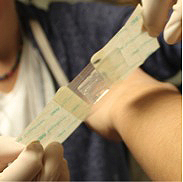How do tissue regeneration, diabetic foot ulcers and oxygenated fluid technology from a late-eighties sci-fi movie come together?

Close-up of the oxygenated hydrogel bandage that is a promising advance in wound dressing.
In 1989, “The Abyss” took movie audiences deep under the ocean and briefly explored the use of a special oxygenated fluid, which allowed breathing within a liquid. Inspired by the film, Dr. Nic Leipzig, a UA associate professor of chemical and biomolecular engineering, invented OXAID, an oxygenated hydrogel that serves a much different purpose — promoting the healing of chronic wounds like diabetic foot ulcers.
On June 17, O2 RegenTech, the startup Leipzig created with biomedical entrepreneur Andreas Inmann, won $10,000 in the JumpStart Up and Comers Pitch Competition. The company placed second among 12 startups that were selected as top opportunities from northeast Ohio universities and business incubators.
Promising technology to help patients
Worldwide, a leg is amputated every 30 seconds as a result of a diabetic foot ulcer. Such a severe chronic wound occurs because of a combination of poor blood flow to fingers and toes and nerve damage — impairing a diabetic patient’s ability to feel wounds and notice developing infections. The lack of sensation from nerve damage can result in a diabetic driving a nail through their foot without realizing it’s there, or failing to notice an infection until it becomes untreatable.

Dr. Nic Leipzig
Healing a diabetic foot ulcer requires three things: moisture, oxygen and antimicrobial properties, Inmann explains. Current treatments include hydrogels that provide moisture and antimicrobials or hyperbaric treatments that deliver oxygen to the wound for a short period of time.
“OXAID marries the benefits of oxygen treatment with hydrogel dressings,” says Leipzig, adding that OXAID could be the first product on the market to offer all three things required for chronic wound healing in a single dressing.
“It’s fantastic technology, otherwise I wouldn’t pursue it,” Inmann adds. Before he was CEO of O2 RegenTech, Inmann was introduced to Leipzig through UA’s Proof of Concept Initiative, which matches mentors with early stage UA technologies.
Testing to continue
Leipzig’s lab worked with Northeast Ohio Medical University to do initial preclinical testing. O2 RegenTech plans to license the technology and continue testing needed for a Federal Drug Administration submission.
“It's fantastic to have our hard work and vision highlighted and recognized in a public forum,” Leipzig says. “We have a long way to go in taking our technology to market, and plenty of investment is still needed to get us there.”
Media contacts: Elyse Ball 330-972-6532 or eball@uakron.edu, or Denise Henry, 330-972-6477 or henryd@uakron.edu.

